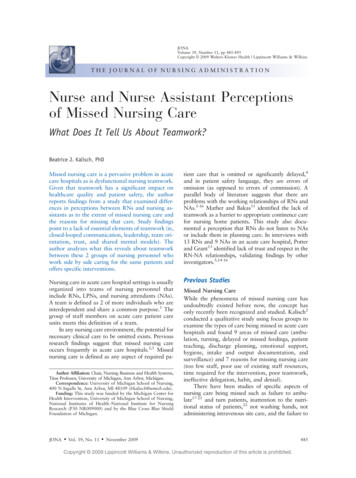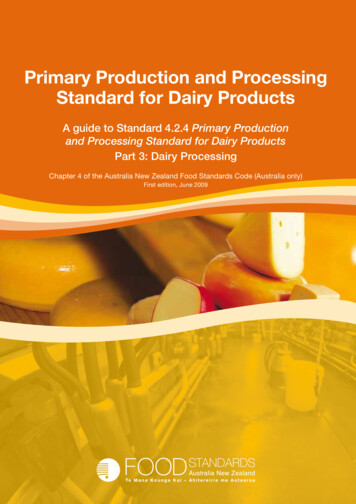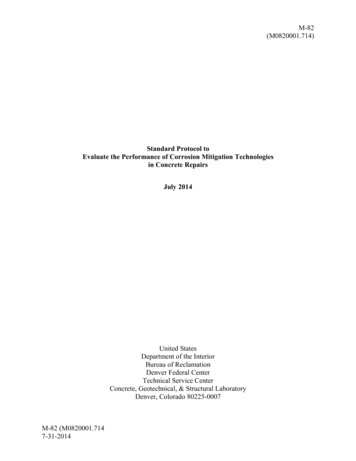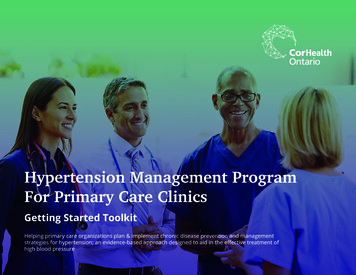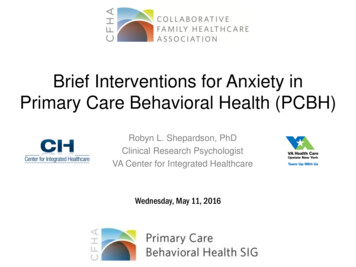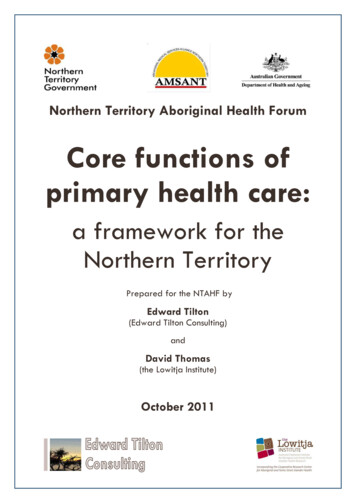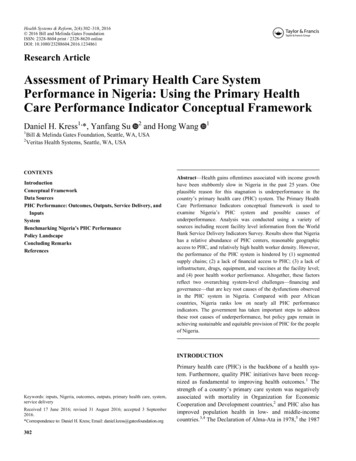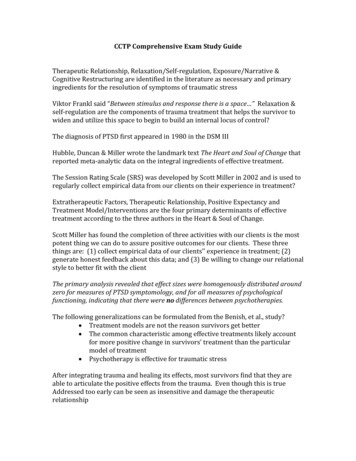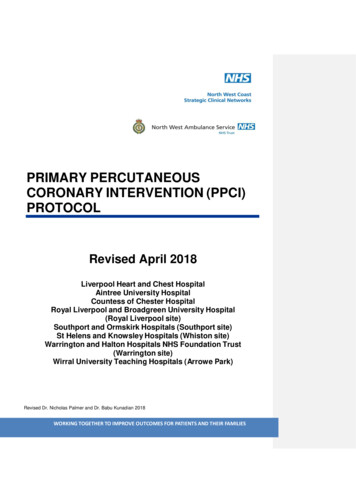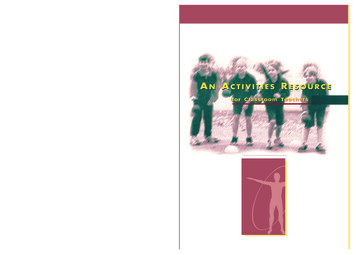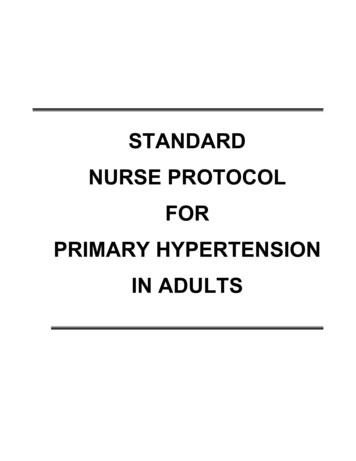
Transcription
STANDARDNURSE PROTOCOLFORPRIMARY HYPERTENSIONIN ADULTS
THIS PAGE INTENTIONALLY LEFT BLANK
Department of Public HealthNurse Protocols for Registered Professional Nurses20152015 HYPERTENSION CLINICAL REVIEW TEAMPatricia Jones, RNChronic Disease Prevention SectionDepartment of Public HealthWilliam R. Grow, MD, FACPDistrict Health DirectorSouth Health DistrictMedical ConsultantNatalie Keadle, RN, MSNAdult Health CoordinatorNortheast Health DistrictKelly Knight, RN, BSNClinical Nursing CoordinatorSouth Central Health DistrictGina Richardson, RNCounty Nurse ManagerBurke County Health DepartmentKimberley Hazelwood, Pharm DDirector of PharmacyGeorgia Department of Public HealthTammy Burdeaux, RN, BSN, CRNIDistrict Nursing and ClinicalCoordinatorEast Central Health DistrictGreg French, RD, LD, CPTDeKalb County Board of HealthLawton C. Davis, MDDistrict Health DirectorSouth Central Health DistrictGayathri Kumar, MDMedical Officer/EpidemiologistGeorgia Department of Public HealthStephen Goggans, MD, MPHDistrict Health DirectorEast Central Health DistrictThis protocol update was developed with funding through the Association of State and TerritorialHealth Officials Million Hearts Learning Collaborative from the Centers for Disease Control andPrevention. The clinical review team acknowledges the contributions to the protocol ofDepartment of Public Health staff Jean O’Connor, JD, DrPH, Brittany Taylor, MPH, Kenneth Ray,MPH, Yvette Daniels, JD, and J. Patrick O’Neal, MD, MPH.Hypertension
Department of Public HealthNurse Protocols for Registered Professional Nurses2015THIS PAGE INTENTIONALLY LEFT BLANKHypertension
Department of Public HealthNurse Protocols for Registered Professional Nurses2015TABLE OF CONTENTSHYPERTENSION14Primary Hypertension in Adults14.1Appendix A: Definitions and Recommendations for Lifestyle Modifications14.23Appendix B: Proper Technique for Blood Pressure Measurement14.25Appendix C: Educational Resources14.28Figure 1:Elevated Blood Pressure Flowchart14.29Figure 2:Blood Pressure Treatment Algorithm for Adult with NoDiabetes or Chronic Kidney Disease14.31Hypertension
Department of Public HealthNurse Protocols for Registered Professional Nurses2015THIS PAGE INTENTIONALLY LEFT BLANKHypertension
Department of Public HealthNurse Protocols for Registered Professional Nurses2015STANDARD NURSE PROTOCOL FORPRIMARY HYPERTENSION IN ADULTSDEFINITIONPrimary (Essential) Hypertension is defined as systolic blood pressureequal to or greater than 140 mmHg or diastolic blood pressure equalto or greater than 90 mmHg on at least two subsequent occasions, ortaking antihypertensive medication with goal of maintaining a normalblood pressure. Secondary hypertension is a type of hypertensionwith an underlying, potentially correctable cause.The three objectives for evaluation of patients with documentedhypertension are to:ETIOLOGY1.Assess lifestyle and identify other cardiovascular riskfactors or concomitant disorders that may contribute tohypertension and may affect prognosis and can guidetreatment.2.Assess for the presence or absence of target organdamage and cardiovascular disease, the extent of disease,and the response to therapy.3.Identify known underlying causes of secondaryhypertension, such as chronic kidney disease, coarctationof the aorta, cushing’s syndrome, drug-induced drugrelated, obstructive uropathy, pheochromocytoma, primaryaldosteronism, renovascular hypertension, sleep apnea, orthyroid or parathyroid disease.1.Primary hypertension/high blood pressure (HBP) appears to bea multi-factorial disease/disorder in which several genesinteract with each other and with the environment.2.Contributing Risk Factors for Hypertension include:a.b.d.e.f.g.Family history of premature cardiovascular disease(men aged less than 55 and women aged less than 65).AgeRace or ethnicity (African American)Overweight/obesity-BMI greater than 24.5Habitual high salt intakeSedentary lifestyle-little to no moderate to vigorousactivity in the past 30 daysHypertension14.1
Department of Public HealthNurse Protocols for Registered Professional Nurses2015h.i.j.k.l.3.Contributing Risk Factors for Cardiovascular ol intake greater than moderate drinking (morethan one drink per day for women and more than 2drinks per day for men)Any tobacco or nicotine useDiabetes mellitusMicroalbuminuriaRenal diseaseHypertensionAbnormal lipids (Total cholesterol 200 mg/dl orgreater; HDL less than 40 mg/dl; LDL greater than100 mg/dl; triglyceride greater than 150 mg/dl)Diabetes and prediabetesAny tobacco or nicotine useObesity or overweight-Body Mass Index greater than24.5Physical inactivity-little to no moderate to vigorousactivity in the past 30 daysFamily history of premature cardiovascular disease(men aged less than 55 and women aged less than65)History of preeclampsia during pregnancyAgeAlcohol intake Alcohol intake greater than moderatedrinking (more than one drink per day for womenand more than 2 drinks per day for men)1.Normally no symptoms. (Headaches, dizziness, or nosebleedsdo not occur any more often in persons with hypertension.)2.May or may not have personal or family history of hypertension.3.The following medical history should be elicited:a.b.c.d.e.Known duration/levels of elevated blood pressure.Past or current symptoms of coronary heart disease,heart failure, cerebrovascular disease, peripheralvascular disease, renal disease, diabetes mellitus,dyslipidemia, sleep apnea or sexual dysfunction.History of symptoms of gout.Recent changes in weight, leisure-time activity, smokingor other tobacco use, or recreational drug use.Results and adverse effects of:Hypertension14.2
Department of Public HealthNurse Protocols for Registered Professional Nurses2015f.g.h.i.4.May have one or more of the following symptoms suggestiveof target organ damage and/or clinical cardiovascular disease(e.g., left ventricular hypertrophy [LVH], angina, priormyocardial infarction [MI] or coronary revascularization, heartfailure, stroke or transient ischemic attack [TIA], neuropathy,peripheral arterial disease, chronic kidney Previous antihypertensive therapy.2)Other prescription and/or OTC medications.3)Alternative therapies (e.g., herbal).4)Homeopathies.Family history of hypertension, cardiovascular disease,diabetes and/or dyslipidemia or causes of secondaryhypertension.Results of previous medical assessments of possiblecauses of hypertension (e.g., labile hypertension orparoxysms of hypertension accompanied by headache,palpitations, pallor and perspiration; abdominal bruits orabdominal or flank masses; delayed or absent femoralartery pulses or decreased blood pressure in the lowerextremities; hypokalemia; hypercalcemia; elevatedcreatinine).Diet history, including intake of sodium chloride,alcohol, saturated fat and caffeine.Psychosocial and environmental factors (e.g., familysituation, employment status, working conditions,educational level).Visual disturbances.Chest pain.Shortness of breath.Edema.Dizziness.Headache.Confusion or other neurological symptoms (e.g., difficultywith speech or movement, facial or one-sidednumbness).Nocturia, urinary frequency, urinary incontinence.Systolic BP (SBP) equal to or greater than 140 mmHg AND/ORdiastolic BP (DBP) equal to or greater than 90 mmHg (basedon the average of at least two measurements (separated by 2minutes). Have patient sit quietly for at least 5 minutesbefore checking the blood pressure and should haveavoided caffeinated beverages and smoking for at least 30Hypertension14.3
Department of Public HealthNurse Protocols for Registered Professional Nurses2015minutes before obtaining measurement. With the patientseated, feet flat on the floor and the arm supported at heartlevel, measure the blood pressure (BP) in each arm, unlesscontraindicated in one arm, using the correct bloodpressure cuff size. The length of the cuff bladder shouldencircle at least 80% of the arm and wide enough toencircle 40% of the arm at midpoint. Cuffs that are toolarge may result in readings that are too low, if cuff is toosmall, may result in readings that are too high. SeeAppendix B on page 6.23 for Proper Blood PressureMeasurement.Recommended cuff sizes:Arm Circumference22 to 26 cm27 to 34 cm35 to 44 cm45 to 52 cmAdult Cuff SizeSmall adult (12x22 cm)Adult (16x30 cm)Large adult (16x30 cm)Adult thigh (16x42 cm)Indicate in the patient’s record the arm with the higher reading.The arm with the higher reading is to be used for ongoingevaluation on subsequent visits.2.Systolic BP (SBP) 120-139 mmHg or diastolic BP (DBP) 8089 mmHg is classified as Prehypertension. Pharmacologictreatment should be initiated in the general populationaged 60 years and older to lower blood pressure at SBPequal to or greater than 150 mmHg or DBP equal to orgreater than 90 mmHg and treat to goal SBP less than 150mmHg and DBP less than 90 mmHg. In the generalpopulation less than 60 years of age, initiatepharmacologic therapy to lower BP to a DBP goal less than90 mmHg and to lower BP to a SBP goal less than 140mmHg. In the population aged 18 years or older with CKDspell out chronic kidney/renal disease and/or diabetes,initiate pharmacologic treatment to lower BP at SBPgreater than 140 mmHg or DBP greater than 90 mmHg andtreat to goal of SBP less than 140 mmHg and goal DBPless than 90 mmHg. See Figure 1 – Elevated BloodPressure Chart on page 6.27.Hypertension14.4
Department of Public HealthNurse Protocols for Registered Professional Nurses20153.When HBP is identified early before target organ damageoccurs, the physical examination usually is normal for thepatient’s age and sex.4.If the BP has been elevated long enough, or if the elevation hasbeen high enough to cause damage or complications, physicalexamination findings may include:a.b.c.d.f.g.ASSESSMENTOptic Fundi - Narrowing, copper-wiring, or A.V. nicking;hemorrhages, exudates or papilledema.Chest & Lungs - Rales or congestion.Heart - Left ventricular hypertrophy (LVH), prematureventricular contractions (PVCs), a gallop, unequalblood pressure in both arms, and/or a displaced pointof maximal impulse.Arterial Pulses – Bruits auscultated over the carotidarteries or abdominal aorta; distended neck veins,femoral arteries and/or renal arteries.Extremities – Edema and/or venous pooling, abnormalperipheral arterial pulsations, intermittent claudication.Neurologic - One-sided weakness, cranial nerveweakness, or hyperactive reflexes on the side of an oldstroke.Primary (Essential) Hypertension(Subjective and objective findings do not indicate a cause of thehypertension.)1.If secondary hypertension is suspected becausesubjective and/or objective findings indicate target organdamage (heart, brain, renal disease, peripheral arterydisease or retinopathy), coarctation, Cushing’s syndrome,or pheochromocytoma, refer the patient to a physician forfurther evaluation. Symptoms and findings that mightsuggest a need for further study or referral include:a.b.c.d.e.f.g.h.i.Bruits in the carotid, abdominal, or femoral areasPalpable kidneysEpisodes of sweating, tachycardia, and headacheAbsence of femoral pulsesUnequal blood pressure in right and left armsPalpitations and paroxysmal symptomsCushingoid-like appearance (i.e., moon face, buffalohump, truncal obesity, striae)Hypokalemia/hyperkalemiaSleep apnea, such as excessive daytime sleepinessHypertension14.5
Department of Public HealthNurse Protocols for Registered Professional Nurses2015PLAN2.Consult with Delegating Physician or his/her designee ifpatient presents with systolic blood pressure equal to orgreater than 200 mmHg and/or diastolic blood pressure isequal to or greater than 110 mmHg.3.Call 911 if patient presents with complaints of chest pain,shortness of breath, severe headache, sudden numbnessor weakness of face, arm, or leg on one side, visualdisturbances, trouble speaking or understanding,dizziness, loss of balance or coordination.4.Document all referrals, consultations, and actions taken.DIAGNOSTIC STUDIESIf the hypertension is identified early, diagnostic studies should bewithin normal limits. They may be abnormal if the BP has beenelevated for a long time or is high to the point that it can causetarget organ damage.For baseline evaluation:1.2.3.4.5.6.7.8.9.10.Complete Blood Count (CBC)Serum PotassiumSerum CreatinineFasting Blood Glucose or Hemoglobin A1c (if diabetesmellitus is known or suspected)Serum SodiumFasting Total Cholesterol and Lipid ProfileCalciumUrinalysis-initial screen may be by dipstick; full urinalysis bylaboratory for any positive resultsECGMicroalbumin by dipstickTHERAPEUTICThe goal of therapy for hypertension is to minimize end-organ damage bylowering blood pressure. This may be accomplished with only lifestylemodification, or a combination of lifestyle changes and medications.NON-PHARMACOLOGIC MEASURESReview the following lifestyle modifications with all patients, as applicable:Hypertension14.6
Department of Public HealthNurse Protocols for Registered Professional Nurses20151.Counsel regarding the Dietary Approaches to StopHypertension (DASH), Reduced Sodium Diet. For intain desirable body weight or Body Mass Index of18.5-24.9 Kg/m².3.Reduce daily sodium intake to less than 2,300 milligrams(mg). Reduce intake to 1,500 mg among persons who are51 or older, African American or have hypertension,diabetes, or chronic kidney disease.4.Reduction of dietary fats and cholesterol to meet DASHrecommendations.5.Moderation of alcohol intake (less than one ounce [30mL]ethanol/day for men and less than 0.5 oz. [15mL] for women).One ounce of ethanol equals 24 oz. beer, 10 oz. wine, or 3 oz.80-proof whiskey.6.Adequate dietary potassium intake (if renal function is normaland not taking drugs known to raise potassium, such as ACEInhibitors) of 4700 mg/day. Foods that are high in potassiuminclude bananas, potatoes, beans and yogurt.7.Adequate intake of calcium, 1000-1500 mg/day based on age.8.Choose foods that provide more potassium for patients who arenot hyperkalemic, dietary fiber, calcium, and vitamin D. Thesefoods include vegetables, fruits, whole grains, and skim orlow-fat milk and milk products.9.Regular aerobic physical activity at least 30 minutes per day,most days of the week.10.Smokers and tobacco users should receive cessation counselingand be referred to the Georgia Quit Line 1-877-270-STOP (7867).NOTE: Refer to the latest Dietary Guidelines for Americans 2010,Appendices 12 and 14 for foods rich in potassium andcalcium at m until the Dietary Guidelines forAmericans 2015 are released.Hypertension14.7
Department of Public HealthNurse Protocols for Registered Professional Nurses2015NOTE: Refer to Appendix A on page 14.21 for Definitions andRecommendations for Lifestyle ModificationsPHARMACOLOGICThe general principles of drug therapy in the treatment of primary hypertensionare based on 2014 Joint National Committee Recommendations.1.Initiate drug therapy for hypertensive persons aged 60 years orolder to a blood pressure goal of less than 150/90 mmHg andhypertensive persons 30-59 years of age to a systolic goal of lessthan 140 mmHg and diastolic goal of less than 90 mmHg. Thesame thresholds and goals (less than 140/90) are recommendedfor hypertensive adults with diabetes or nondiabetic chronickidney disease as for the general hypertensive populationyounger than 60 years.2.Start one drug, titrate to a maximum dose. If BP goal is notachieved with the initial drug at maximum dose, add a seconddrug from another class (thiazide-type diuretic, CCB, ACEI, orARB) and titrate to maximum dose. If BP goal is not achievedwith maximum dose of 2 drugs, select a third drug from the list(thiazide-type diuretic, CCB, ACEI, or ARB), avoiding thecombined use of ACEI and ARB. Titrate the third drug up tomaximum recommended dose to achieve goal BP. If goal BPcannot be reached using the drugs included in this protocol ordue to any contraindication or the need to use more than 3 drugsto reach goal BP, referral to a physician may be indicated.3.In the general nonblack population, including those withdiabetes, initial antihypertensive treatment should include athiazide-type diuretic, calcium channel blocker (CCB),angiotensin-converting enzyme inhibitor (ACEI), or angiotensinreceptor blocker (ARB).4.In the general black population, including those with diabetes,initial antihypertensive treatment should include a thiazide-typediuretic or calcium channel blocker (CCB).5.Patients with diabetes mellitus most likely will require a 2 drugregimen.6.Be familiar with local discount drug programs and keep an up-todate list. To the extent possible, order medications from theselists. Consult with the delegating physician as appropriate.Hypertension14.8
Department of Public HealthNurse Protocols for Registered Professional Nurses20157.It is essential to assess patient medication adherence andlifestyle modifications.8.To improve medication adherence, order once per day dosing asappropriate.9.This protocol is for Primary Hypertension and does not includetreatment for patients with impaired kidney function or ChronicKidney Disease, heart failure or other complicated factors.10.Patients who are pregnant, planning to become pregnant, orbreast-feeding must be referred to an obstetrician formanagement of hypertension.11.Thiazide-type DiureticsNOTES:a.b.Do not give to patients with a known sensitivity to thedrug, any component of the formulation or sulfonamidederived drugs or anuria.Thiazide-type Diuretics may cause (not all-inclusive list,refer to package insert):1.2.3.4.A change in glucose control in patients withprediabetes or diabetes mellitus.In patients with a history of gout, may precipitategout event.In patients with moderate or high cholesterolconcentrations, may increase cholesterolconcentrations.Patients may experience fluid or electrolyteimbalances.Hydrochlorothiazide (HCTZ) tabletsInitial dose: 12.5 mg - 25 mg PO once daily. For olderpatients, consider starting with a lower initial doseof 12.5 mg and titrating to response.Usual dose: 25 mg to 50 mg PO once daily in 1-2divided doses.ORIndapamideHypertension14.9
Department of Public HealthNurse Protocols for Registered Professional Nurses2015Initial dose 1.25 mg PO once daily but if inadequate,dosage may increase to 2.5 mg PO daily.Usual dose: 1.25 mg to 2.5 mg PO dailyNote: Indapamide has not been shown to adverselyaffect lipids.If patient does not gain control of BP, or BP does notsteadily decrease after 3-4 weeks, increase dosage.If BP is still uncontrolled, add a second drug fromanother appropriate class.Thiazide-type diuretics are often available incombination products.NOTE: If a diuretic is the initial drug, the second drugmay be from any other drug class that fits with thepatient assessment. However, if a drug from anotherclass besides a diuretic was chosen initially, then thesecond drug should almost always be a diuretic.AND/OR(up to a total of 3 drugs, each from a different class)12.Angiotensin Converting Enzyme Inhibitor (ACEI) and AngiotensinReceptor Blockers (ARBs):Notes:a.b.Do not give the following ACEI or ARB to patients with aknown hypersensitivity to the drug or any component ofthe formulation. For patients who are diabetic and are alsotaking an ACEI or ARB, they should not take aliskiren ifGFR is estimated to be below 60 mL/min (mild loss ofkidney function) because the combination may enhancethe nephrotoxic effect of the ACEI or ARB. Other patientsshould be monitored for serum potassium, serumcreatinine, and blood pressure periodically.Do not use an ACEI and ARB as concomitant therapy in apatient.Hypertension14.10
Department of Public HealthNurse Protocols for Registered Professional Nurses2015c.d.Black patients have a smaller response to monotherapy ofACEI and ARBs.Angiotensin Converting Enzyme Inhibitor (ACEI) andAngiotensin Receptor Blockers (ARBs) may cause (not allinclusive list, refer to package insert):1)2)3)Angioedema, with the highest frequency within thefirst 3 months of therapy but may occur with the firstdose (less likely with ARB)Dry, hacking, nonproductive cough, usually occurswithin the first few months of treatment andgenerally resolves within 1-4 weeks afterdiscontinuation (less likely with ARB).Hyperkalemia, potassium should be monitoredappropriately.12. A. Angiotensin Converting Enzyme Inhibitor (ACEI)1.For those drugs listed with once or twice daily dosing, theantihypertensive effect may diminish toward the end of thedosing interval especially with the lower dosing. Anincreased dosing may aid in extending the duration ofantihypertensive effect or the need to divide the dose fortwice-daily dosing should be assessed by monitoring peakand trough responses.Lisinopril tablet 10-40 mg PO dailyInitial Dose: 10 mg PO once daily, not maintained ona diuretic or 5 mg PO once daily, maintained on adiuretic or volume depleted. For older patients,consider starting with a lower initial dose andtitrating to response.Usual dose: 10 mg to 40 mg PO once daily.OREnalapril MaleateInitial Dose: 5 mg PO once daily, not maintained on adiuretic or 2.5 mg PO once daily, maintained on adiuretic or volume depleted. For older patients,consider starting with a lower initial dose andtitrating to response.Hypertension14.11
Department of Public HealthNurse Protocols for Registered Professional Nurses2015Usual dose: 10-20 mg PO daily in 1 or 2 divideddosesORBenazepril HCLInitial Dose: 5 mg PO once daily, if maintained on adiuretic or volume depleted and 10 mg PO once dailyif not maintained on a diuretic. For older patients,consider starting with a lower initial dose andtitrating to response.Usual dose: 10 mg to 40 mg PO daily in 1 or 2divided dosesIf patient is compliant after 2-3 weeks but BP is notdecreasing, increase dosage until control is gained,side effects become intolerable, or maximum dosageis reached.OR12. B. Angiotensin Receptor Blockers (ARBs)Losartan PotassiumInitial dose: 25 mg PO once daily, if maintained on adiuretic or volume depleted or 50 mg PO daily if notmaintained on a diuretic.Usual dose: 50-100 mg PO daily in 1 or 2 divideddosesORValsartanInitial dose: 40 mg PO once daily, if maintained on adiuretic or volume depleted or 80 mg PO daily inpatients who are not maintained on a diuretic orused as monotherapy. Dose may be increased toachieve desired effect.Usual dose: 80-320 mg PO dailyHypertension14.12
Department of Public HealthNurse Protocols for Registered Professional Nurses2015ORIrbesartanInitial dose: 75 mg PO once daily, if maintained on adiuretic or volume depleted and 150 mg PO oncedaily, if not maintained on a diuretic.Usual dose: 150 mg-300 mg PO dailyIf patient is compliant after 2-3 weeks but BP is notdecreasing, increase dosage until control is gained,side effects become intolerable, or maximum dosageis reached.AND/OR(up to a total of 3 drugs, each from a different class)13.Calcium Channel BlockerNotes:a.Non-dihydropyridine calcium channel blockers (e.g.,diltiazem, verapamil) offer a small protective effect onproteinuria in diabetic nephropathy beyond theirantihypertensive action. There is a small additional benefiton proteinuria from addition of nondihyropyridine CCBs toangiotensin-converting enzymeinhibitors.b.Calcium Channel Blockers may cause (not all inclusive list,refer to package insert):1)Constipation2)Interaction with grapefruit products3)Swelling in the feet or hands4)Gingival hyperplasiad.Concomitant use of nondihydropyridine calcium channelagents (e.g., verapamil, diltiazem) and β-adrenergicblocking agents can have additive negative effects onmyocardium contractility, heart rate, and AV conductionand they may inhibit the metabolism of certain betablockers.DihydropyridineAmlodipine BesylateHypertension14.13
Department of Public HealthNurse Protocols for Registered Professional Nurses2015Initial Dose: 2.5 mg PO once daily may be used whenadding amlodipine to other antihypertensivetherapy. If used as monotherapy, can initiate at 5 mgPO once daily. Older patients should be initiated at2.5 mg. In general, titrate in 2.5 mg increments, wait7 to 14 days between titration steps.Usual dose: range 5 mg to 10 mg PO once dailyORNon-dihydropyridinesDiltiazem Extended ReleaseInitial Dose: 120 mg to 180 mg PO once dailyFor older patients, consider starting with 120 mg asan initial dose and titrating to response.Usual dose: 240 mg to 360 mg PO once dailyAntihypertensive effects usually are evident withinthe first week. If patient is compliant after 2 weeksbut BP is not decreasing, increase dosage untilcontrol isgained, side effects become intolerable, or maximumdose is reached (360 mg/day).ORVerapamil HCL Sustained-Release (SR)Note: Please see individual manufacturer insert todetermine if the sustained-release form can besafely broken in half. Base on therapeutic efficacyand safety, evaluate weekly and approximately 24hours after the previous dose. Usually the firstantihypertensive effects are evident within the firstweek of therapy.Initial Dose: 180 mg PO given in the morning. Lowerinitial dosages of 120 mg/day may be warranted inHypertension14.14
Department of Public HealthNurse Protocols for Registered Professional Nurses2015patients who may have an increased response (e.g.,elderly patients, patients of small stature.)If adequate response is not obtained with 180 mg,the dosage may be titrated upward in the followingmanner at weekly intervals to appropriate response:240 mg each morningTHEN if needed, titrate up with either 180 mg eachmorning, plus 180 mg each eveningOR240 mg each morning plus 120 mg each eveningUsual dose: 240 mg to 360 mg daily120 mg sustained-release (SR) up to 360 mg/dayDosage should be adjusted according to patient’sblood pressure response.If BP still is uncontrolled, add a diuretic, ifappropriate, or another appropriate drug from adifferent class, OR, substitute another appropriatedrug from a different class.PATIENT EDUCATION/COUNSELING1.Treatment Regimen-Emphasize the importance of adherence withall aspects of the treatment plan: diet, lifestyle changes,medications and importance of keeping follow-up appointments.See Appendix C – Educational Resources on page 6.26.a.b.c.d.e.f.Establish blood pressure goals and review readings oneach visit.Ask patient what he/she has been doing since the last visitto control their blood pressure.Ask patient specifically what he/she would like to work onto improve his/her blood pressure.Ask patient what he/she thinks would make it easier tocontrol his/her blood pressureAsk patient to tell you how he/she has been taking his/hermedication(s).Ask if patient sometimes forgets to take his/hermedication(s)Hypertension14.15
Department of Public HealthNurse Protocols for Registered Professional Nurses2015g.h.Ask if patient has had any side effects and if he/she hasconcerns about side effects.Advise patient when and how to contact the clinician withquestions or problems.2.Refer to a Registered Dietitian or Public Health Nutritionist, for DASHEating Plan counseling. Nurses are to provide counseling on DASHEating Plan if no Registered Dietitian or Public Health Nutritionist isavailable and reinforce counseling on follow-up visits.a.Attain/maintain sodium intake to 1,500 mg among persons whoare 51 or older and those of any age who are African Americanor have hypertension, diabetes, or chronic kidney diseaseb.Attain/maintain fat consumption to no more than 25-30% ofcalories.c.Achieve/maintain desirable body weight/BMI.d.Use alcohol and caffeine in moderation.e.Use foods rich in potassium content especially if taking apotassium-wasting diuretic (e.g., HCTZ) up to 4700 mg/dayf.If impaired renal function or on ACE Inhibitor therapy, avoid saltsubstitutes because of potassium content.g.Attain and maintain adequate calcium intake appropriate forage.3.Risk Factorsa.b.c.4.Sedentary lifestyle - assist the patient to establish a physicalactivity plan and discuss the importance of regular aerobicphysical activity at least 30 minutes per day most days of theweek.Smoker or nicotine user- Utilize Ask, Advise and Refer(AAR) model and provide cessation counseling andreferral to the Georgia Quit Line 1-877-270-STOP (7867)using the Quit Line Fax Back Form as appropriate.Hypercholesterolemia - provide nutrition counseling andpromote adherence to a low cholesterol/low fat diet to decreasecholesterol level.Counsel the patient about the signs and symptoms of stroke and heartattack. Stress that both conditions are medical emergencies and tocall 911 (or for an ambulance where 911 is not locally available).a.Signs and symptoms of stroke may include: sudden numbnessor weakness in the face, arm or leg, especially on one side ofthe body; sudden confusion or trouble speaking orunderstanding; sudden trouble seeing in one or both eyes;Hypertension14.16
Department of Public HealthNurse Protocols for Registered Professional Nurses2015b.5.sudden trouble walking, dizziness, loss of balance orcoordination; sudden severe headache with no known causeSigns and symptoms of heart attack may include:uncomfortable pressure, fullness, squeezing or pain in thecenter of the chest lasting more than a few minutes; painspreading to the shoulders, neck or arms; chest discomfort withlightheadedness, increased sweating, profound weakness,fainting, nausea or shortness of breath.Assess and administer vaccines indicated according to the currentAdvisory Committee on Immunization Practices (ACIP) childhood oradult immunization schedule (i.e., those recommended for personswith chronic medical conditions). See the Georgia ImmunizationProgram Manual, Recommended Schedule and Guidelines, forcurrent ACIP schedules and administration guidelines for eachvaccine. The Georgia Immunization Manual may be accessed on lin
May 11, 2015 · 1. Assess lifestyle and identify other cardiovascular risk factors or concomitant disorders that may contribute to hypertension and may affect prognosis and can guide treatment. 2. Assess for the presence or absence of target organ damage and cardiovascular diseas
